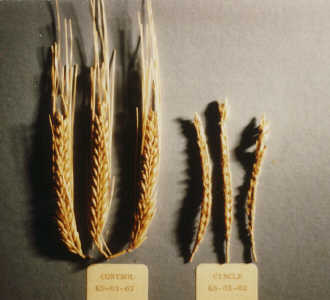
Posted on 10/04/2008 9:41:56 AM PDT by Justice Department
Another crop circle has appeared in the English countryside — and this one's clearly been made by someone, or something, that understands math.
(Excerpt) Read more at foxnews.com ...
It’s a shame FR doesn’t have an “Anonymous Coward” (eg: /.) posting option.
Let’s just say that, uh, I wouldn’t be surprised if the intricate circles are done by nerds with too much time on their pale hands. Some of them may even be part of the debunking crowd. :)
Ooh, look! A UFO!
“”Most scientists, however, sniff at the suggestion, pointing out that anyone with planks and rope can create crop circles in a couple of hours.”
There was a very good program on TV about crop circles.
They gave very good demonstrations of how they are made, down to the fake radiation burns on the stalks.
Of course the plank and rope is the key tool.
They did demonstrations that made it look so easy.

((square root of 5)-1) divided by 2
Surely, aliens like pi!

SEED-HEADS, WHEAT Crop circle seed-head (right) has no seeds, due to destruction of plant's reproductive capacity. Found only when crop circles occur in very immature plants.
Whatever and whoever—these things are really interesting to look at. I’m always taken by how well they keep the edges clean. Some of them are certainly works of art, IMHO.
http://www.bltresearch.com/plantab.html
PLANT ABNORMALITIES
“The physical changes (listed below) documented in crop circle plants by Michigan biophysicist W.C. Levengood have been determined by evaluating hundreds of sample plants — both downed and standing — taken from inside the overall perimeter of each formation against hundreds of control plants taken at varying distances outside each formation, in several directions. More than 250 individual crop formations from multiple countries, over a 10-year period were examined in-depth. Although many of the formations studied were relatively “simple” in overall design and/or relatively “small” in overall size (primarily because of BLT’s financial and/or personnel limitations, particularly in Europe), many larger and more “complex” formations — those whose overall design included intricate geometric shapes with multiple design elements of varying sizes — are represented here.
Many of the formations occurred in European countries and, in those cases, the plants were dried-down in open air for 4-6 weeks prior to shipping to the U.S. Some of the U.S. and Canadian formations were shipped while still green. The physical changes found in these crop circle plants, outlined below, have all been determined to be statistically significant at the 95% level of confidence:
1.
On the microscopic level, abnormal enlargement of cell wall pits in bract tissue (a thin membrane which surrounds the seed- head and through which nutrients pass to the developing seed) were found. This examination utilizes the optical microscope and is quite time-consuming and, although useful in the early, exploratory stages of the research, was replaced when equally reliable criteria were subsequently discovered.
2a.
Enlarged (both laterally and longitudinally) plant stem nodes - the fibrous “knucle-like” protuberances found spaced along the plant stem beneath the seed-head, technically called “pulvini.” Although these nodes are sometimes enlarged both laterally (they are “fatter”) and longitudinally (they are “stretched”), extensive laboratory work has determined that it is the node elongation (the stretching) that is a permanent effect caused by the formation energies - and so this is the parameter now used.
2b.
In some crop formations the energy system involved is intense enough to cause bending of this apical (top) node (although pronounced node bending is much more commonly found at the lower nodes on the plant stem). In a few cases we have found severe apical node bending in conjunction with marked stretching of the node. As the example, below, illustrates the node elongation in such cases is clearly in addition to that caused by the bending of the node tissues.
3a.
Marked bending of the plant stem nodes which can occur at all of the nodes in some cases, is most often observed in the 2nd, 3rd and 4th nodes down toward the bottom of the stalks. It does occasionally occur in the first, or apical node beneath the seed-head (see above). Usually this bending (if it is determined to be significant after ruling out natural plant recovery processes) is in the range of 45-90 degrees and considerable care must be taken to not confuse this node bending with two well-known plant recovery processes:
(1) phototropism (the plant’s natural tendency to reorient itself to sunlight) and;
(2) gravitropism (the plant’s natural tendency to reorient itself to the earth’s gravitational field).
Depending upon the growth-stage of the plant at the time it is downed (whether it is young or old) and the species of crop involved, these natural recovery processes - phototropism and gravitropism - begin to take effect within days. Therefore node bending can only be understood as significant when it is known how old the affected crop was at the time the crop circle occurred and, particularly, how many days have elapsed since then. [Young barley, for instance, begins recovery to the up-right position almost immediately and will show significant node bending within a week; young wheat tends to recover slightly more slowly. And mature crop may not reorient itself at all, depending on the amount of vigor inherent in the plants.] But when crop circles are known to have formed during a specific time period and are found within 24-48 hrs., and significant node bending (40° +) is observed, this is an effect that can be attributed to the causative energy system. In some cases canola (rape-seed) plants have been observed to be bent at a full 180°.
3b.
Bending at the base of the plant stem is a totally separate condition which is thought by many people to indicate that any formation in which it is found is “genuine” (not mechanically flattened). This type of bending is found at the very bottom of the stem, where it comes out of the earth, and is often quite pronounced.
Although this particular parameter has not been scientifically evaluated, it is known that mechanical flattening (with planks, boards or human feet) of many plants (particularly canola, above) will snap or break the plant stems, rather than bend them. As the summer progresses and the cereal crops - in which a majority of the crop formations occur - dry down, the plants become less and less elastic, making bending at the stem base in these crops perhaps more significant later on in the season.
4.
Expulsion cavities (holes blown out at the plant stem nodes), usually found in the 2nd node beneath the seed-head, but in recent years discovered also in the 3rd and 4th nodes all the way down the plant stem. A darkening of the stem node, particularly when expulsion cavities are present, is usually the result of the growth of an opportunistic fungus (Ustilago tritici) which quickly forms on the exudate released from inside the plant stem........”
More - with photos:
http://www.bltresearch.com/plantab.html
Gee if they are doing it in barly and wheat fields ... I will take a few pints of brew. Just don’t tramp down the HOPS!
I have lived around farmers all my life and never met one with any extra time.



UFO ping
No peer review.
No references.
No chance.
No way could you get those lines after 3 to 5 pints of beer!

Well Duh! I knew that. I didn't think it was that important enough to call anybody..........
 golden...
golden...
Disclaimer: Opinions posted on Free Republic are those of the individual posters and do not necessarily represent the opinion of Free Republic or its management. All materials posted herein are protected by copyright law and the exemption for fair use of copyrighted works.